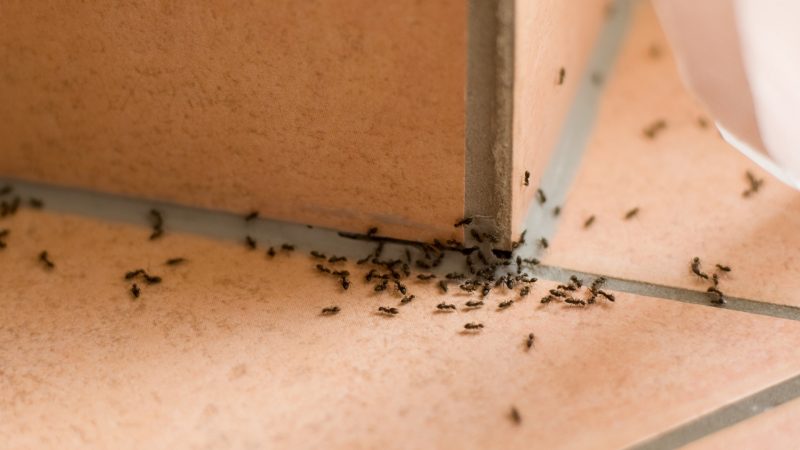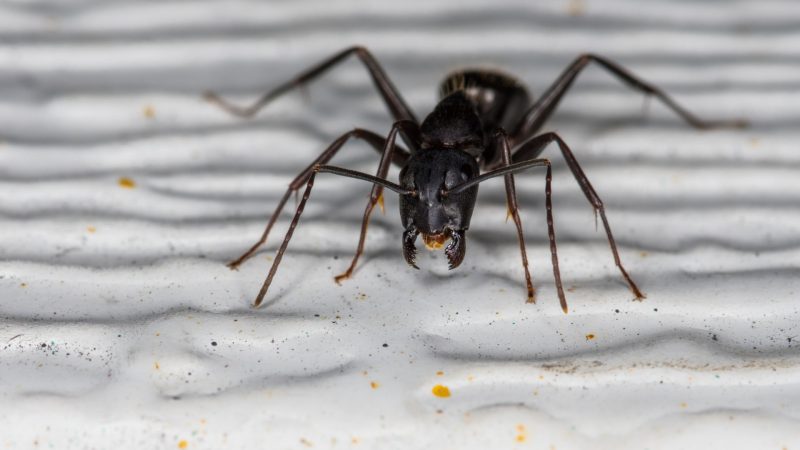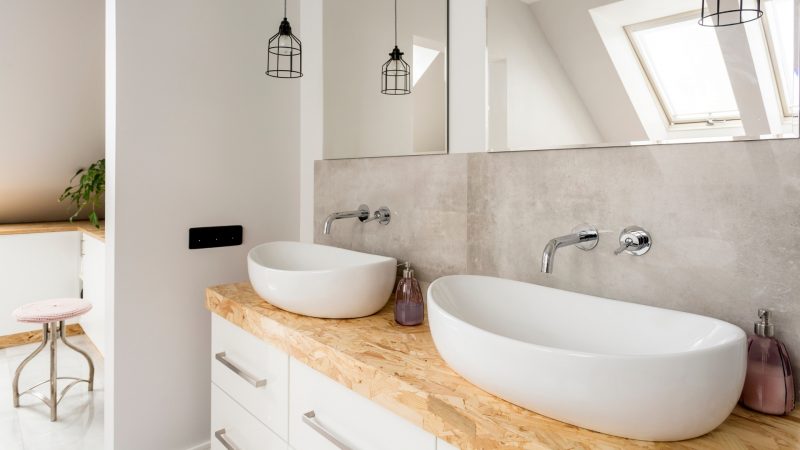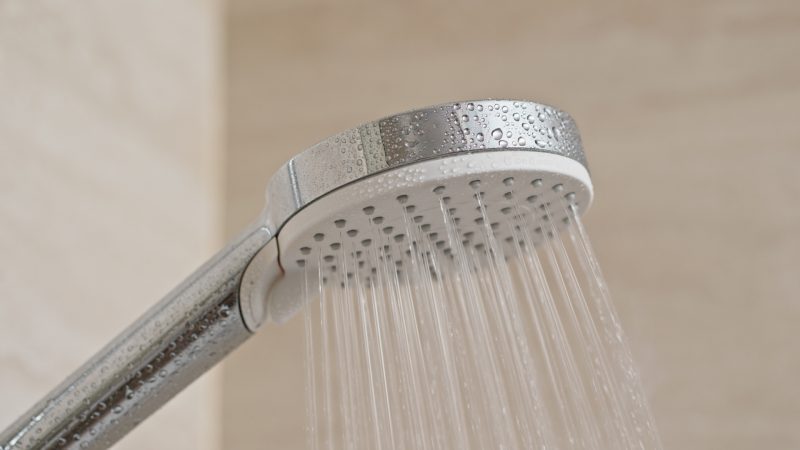Ants are usually attracted to your house due to poor sanitary conditions, in search of better food sources or more favorable environmental conditions. Out of all places inside the house, ants are easily drawn to your bathrooms, which provides the perfect conditions to flourish and establish their colonies.
So, how to get rid of ants in the bathroom? First, inspect the area of infestation and determine what type of ant you’re dealing with. Then, set up ant baits, traps, or liquid insecticides to remove the ants and the rest of the colony. Lastly, prevent them from coming back by fixing the cause of infestation and sealing all entry points.
This comprehensive guide will discuss everything you need to know about ants in bathrooms, why they invade them in the first place, how you can effectively deter them, and how you can prevent this from happening again. Let’s begin!
Ants in Bathroom | Information
Ants are easily drawn to your house, especially bathrooms, due to perfect environmental conditions. It is one of the best places for the ants to breed and develop their colonies. Ants tend to build their nests in darker places, inside drain holes, crevices, near dripping pipes, or under sinks or bathtubs.
They can ruin your bath items and can carry diseases from debris or garbage to your bathroom. The ants have the ability to multiply and establish larger colonies in a very small time period.
Each colony works on a caste system that includes worker ants, soldier ants, male ants (for mating), and female reproductive ants or queens. The colony may contain one or more queen(s) which allows their survival. It is necessary to eliminate the queen in order to exterminate the whole colony.
Why Are There Ants in My Bathroom?

Ants are usually attracted to your bathrooms for food, shelter, and moisture. If you have an unhygienic environment, leaky pipes, cracks, or standing water in your bathroom, these factors are sufficient to attract ants.
Additionally, most adult ants need liquid to process food and dripping pipes, showers and wet floors provide them with perfect surroundings that meet their needs.
The standing water and clogged drains release scent into the surrounding which can draw ants to your bathrooms. The ants are able to process debris and clogged rotten hair as food sources.
Why Are Ants Coming Out of My Bathroom Sink?
If you discover ants coming out of your bathroom sink then there is a higher chance that you have leaky pipes. The ants like to build their shelters near broken drainage pipes. Look for the trails of ants and take preventive measures.
Types of Ants in Bathrooms
It is necessary to correctly identify the ant species in order to take effective preventive measures and to apply the proper pest control methods to tackle the established colonies of ants in your bathroom.
The most common species that you may encounter in your bathroom are the ones that love moisture and warm places. Here’s a list of them:
Sugar Ants in the Bathroom
Sugar ants include a group of ants that mostly prefer sugar-based food content. The moist and dark environment in your bathrooms attract most species of sugar ants. They build their shelters in rooting wooden structures and in other moist areas.
The common indoor sugar ants are pavement ants, carpenter ants, Pharaoh ants or odorous ants. Repair your leaky pipes, and dripping showers, and wipe the excess water from your bathroom floor to prevent the sugar ant infestation.
Carpenter Ants in Bathroom

Water, food, or shelter in rotting wood attracts carpenter ants into your home. Carpenter ants are brown or mostly black in color. Inside the bathroom, you may encounter carpenter ants under wall voids, titles, wooden structures, or at other damp areas.
Due to their powerful jaws, they can penetrate and damage even the hardest places such as damp wooden cabinets and drains. Once they establish colonies, you will discover them coming out of wall voids, crevices, hollow wooden structures, and other damp places.
Moisture Ants in Bathroom
Moisture ants, also known as yellow ants, are attracted to damp wood and behave almost like carpenter ants. They are about 4-5 mm long and yellow to reddish-brown in appearance. They do not excavate dry wood but are able to damage soft or rotten wood structures to build their nests.
If you discover moisture ants, immediately take pest control measures to avoid structural losses in your bathroom. Keep your bathroom dry and clean to prevent their infestation. You can also find various pest control solutions to exterminate moisture ant colonies.
Tiny Black Ants in Bathroom
Tiny black ants are small ants, about 1.5 mm long, that have a dark brown to black segmented body. These ants enter your house in search of warm and moist surroundings. They are quickly attracted to moist places like bathrooms and build their nests inside wall voids, dark places, or under debris.
You can see these tiny ants everywhere looking for water and food, especially after they’ve established their colonies. Keep the floor of your bathroom dry, and clean, and practice good sanitation to prevent their invasion.
Pharaoh Ants in Bathroom
Pharaoh ants are similar to thief ants and can be up to 2 mm long. They have a light yellow to red appearance with black marks at the abdomen. Pharaoh ants, also known as, are also referred to as little red ants due to their small and reddish appearance.
Warm and moist environments in bathroom easily attract this species. They build large colonies rapidly due to their persistent behavior under the sink, with plumbing, in bathtubs, cabinet voids, or behind switchboards.
Crazy Ants in Bathroom
Crazy ants can establish a single colony comprising of millions of individuals. They can easily adapt to a dry environment but prefer to build their nests in damp environments such as bathrooms and kitchens.
They are scavengers, foragers, and predators. These ants can get attracted by the rotten smell of fermenting hair, and debris, or by following the trail of fruity bath products. Crazy ants build nests inside holes, crevices, wall voids, beneath bathtubs, and particularly near damp areas.
Argentine Ants in the Bathroom
Argentine worker ants are up to 3 mm long and have a brown to black shiny appearance. They can also establish colonies made out of a thousand members and even create subcolonies.
They live under cracks, wall voids, and near damp places in your house and can commonly be found in bathrooms due to moist and warm surroundings. The Argentine ants prefer the sugar-based diet and enter your house by following the sweet scent of sugar-based food items.
Odorous House Ants in Bathroom
The odorous house ants are tiny brown or black ants, commonly found inside residential areas. They are drawn to your house by following food trails or due to harsh weather conditions. These ants release a disgusting smell when they get smashed and are attracted to your bathroom due to moisture.
They live inside wall voids, under cracked floors or beneath bathtubs and sinks, and in other dark and damp places. These tiny brown ants multiply quickly and can establish colonies and sub-colonies in a few days.
Pavement Ants in the Bathroom
Pavement ants have a brownish appearance. These ants are up to 3 mm long and live under hollow foundations, floor, or wall voids. They are common indoor ants and are drawn to your bathrooms for warmth, moisture, and food sources.
The swarm of flying pavement ants can be observed in May or June season. To avoid pavement ant infestation first you need to eliminate moisture, keep your bathroom clean and remove debris from drains. Make sure to seal all the cracks and crevices which can provide a nesting area for pavement ants.
Flying Ants in Bathroom
Flying ants or alates are the reproductive ants, they appear during mating season. They are winged ants and swarm mostly during the spring or summer season. You will potentially see flying ants during their nuptial flight in your bathroom ceiling or near the light source.
It is considered to be the perfect place for breeding or mating ants due to the good environmental conditions. The presence of flying ants in your bathroom is an indication of a nearby ant infestation but they can also enter your bathroom from the window or through other entry points.
How to Get Rid of Ants in Bathroom: Step-by-Step Instructions

A few ants may not cause any problems at the beginning but they have the ability to build larger colonies in just a few weeks which can lead to serious issues. Therefore, you need to take these necessary steps to get rid of ants in bathrooms:
Step 1: Inspection of the Infested Area
You first need to look for the root causes of the ant invasion. Stagnant water, leaky pipes, dripping showers, broken pipelines, damp or rotten wooden structures, clogged drains, garbage, or debris attracts ants to your bathroom.
The ants can also enter your bathrooms by following the trails of sugar-based bath items or rotten debris. They build nests under the cracks, crevices, floors, sinks, or bathtubs, in damp wood, near dripping pipes, inside wall voids, or in other areas that contain moisture.
Step 2: Pest Control Methods | Ant Baits and Liquid Insecticides
Ant Baits or Traps
After accurate identification of ant species and level of infestation, select the best ant bait or trap according to the ant type. There are different types of liquid, gel, or solid ant baits or ant traps available commercially such as sugar-based baits or protein-based baits.
You can also change the bait if it does not show positive results. This is the best technique to lure ants out of drains, cracks, holes, or from areas you cannot approach them manually.
Place these baits at the entry points and near the nesting sites of ants in your bathroom. These traps or baits are poisonous and can kill the entire colony in a few days or a few weeks depending upon the level of infestation. Follow the product’s guidelines if you want to see the best results.
Some of our recommended ant baits or ant traps are the following:
- Attracts & Kills – Kills common household ants including...
- Kills the Ants You See & the Ones You Don't – As worker ants...
- Works Fast – You should see a significant decrease in the...
- Ready to Use – Place the bait stations, watch it attract ants,...
- Use Throughout Your Home – Place stations near areas where...
- STARTS KILLING ANTS IN HOURS: Hot Shot MaxAttrax Ant Bait...
- KILLS THE QUEEN COLONY: Works up to 6 months indoors
- INDOOR AND OUTDOOR USE: Use near walls, in closets and cabinets,...
- CHILD RESISTANT: Contains 8 child-resistant bait stations
- Attracts & Kills – Kills common household ants including...
- Kills the Ants You See & the Ones You Don't – As worker ants...
- Works Fast – You should see a significant decrease in the...
- Ready to Use – Insert stakes and cut the tab, then watch it...
- For Outdoor Use – Place the bait stakes in outdoor areas where...
- One 8 count package of Raid Ant Killer Baits protects against...
- Raid Ant Killer works for up to 3 months to help control ants in...
- This pest killer comes in convenient Raid Ant Traps where ants...
- Raid Ant Killer is ideal for use throughout your home, including...
- Try other Raid bug spray and insect killer products for all of...
- Kills the colony.
- Provides long-lasting ant killing power
- Kills ants quickly
- No vapor, fumes, or odor.
- This package contains 6 ant killing bait stations.
Liquid Insecticides
Professionals mostly use toxic insecticides to get rid of ant colonization. There are different types of insecticides available commercially that can help you completely eradicate ant infestation. It is best to use non-repellent insecticide sprays or control solutions.
Make sure to wear personal protective equipment while performing the treatment to avoid direct contact with the toxic chemicals. You can also go for powder insecticides if you do not prefer liquid sprays.
Some of the best liquid insecticides that we recommend are the following:
- Attracts & Kills – Kills common household ants including...
- Kills the Ants You See & the Ones You Don't – As worker ants...
- Works Fast – You should see a significant decrease in the...
- Ready to Use – Place the bait stations, watch it attract ants,...
- Use Throughout Your Home – Place stations near areas where...
- Great Value - 1 Gallon allows for repeated applications to...
- Extended Trigger Sprayer - Use included extended trigger sprayer...
- Long Residual - Continues to kill german roaches, ants, moths,...
- Odorless Formula - Odorless and non-staining formula will not...
- EPA Registered - Registered with the Environmental Protection...
- INSECT KILLER FOR LAWNS & LANDSCAPES: For outdoor use around the...
- UP TO 3 MONTHS* CONTROL: Season-long control of listed pests
- KILLS 260+ LISTED LAWN-DAMAGING INSECTS: Including ants**,...
- COVERAGE: Covers up to 6,400 square feet of lawn for lawn surface...
- MIX WITH WATER: Follow directions on label; Once treated area is...
- Kills over 500 listed pests on vegetables, fruits, ornamentals,...
- Formulated to protect over 250 vegetables and fruits
- Can be used up to one day of harvesting on tomatoes, peppers,...
- Kills common household bugs such as ants, roaches, and spiders...
- Active Ingredients: Zeta-Cypermethrin
- Kill 235 bugs, including ants, ticks, mosquitoes, fleas, spiders,...
- Starts killing within minutes and provides long-lasting control
- For use on lawns, around home perimeter, ornamentals, flowers,...
- Apply with an Ortho Dial N' Spray or tank sprayer when bugs first...
- This product is a concentrate and cannot be applied directly out...
Step 3: Prevention Tips
To prevent ants at early stages, remove the excess moisture and fix all the broken pipes in your bathroom. Wet or damp wood is always a great attraction for ants, therefore, you need to make an effort to keep your wooden frames, wooden cabinets, and other woodwork dry to avoid getting an ant infestation.
Install a proper ventilation system to dehumidify your bathroom after taking a shower. Keep your bathrooms clean and do not leave garbage open or overflowing overnight.
You can use cleanser or other cleansing aids to clean your showers and remove hair or debris from drains. Make sure to mend all the cracks and seal off holes that can provide nesting space for ants.
How to Get Rid of Ants in the Bathroom Sink?
First, identify the reason for the ant infestation under the bathroom sink. If there is a broken pipe or excess moisture, then wipe the area and clean the surface with the help of a cleanser and fix the broken pipeline.
To get rid of ant colonization under the sink, follow the trails of ants and look for their entry points or nesting sites. You can use ant killer sprays or powders if the infested area is easily approachable, otherwise, use ant baits or traps to lure ants out of their nests.
How to Get Rid of Ants in My Bathroom Shower?

To eliminate ant infestation in your shower, you need to first clean the dirt or fungus from your bathroom shower. Inspect if the water channel is tightly sealed. After identification of the invader ant species, use your insecticide spray to exterminate them.
The spray will kill the ants instantly. Do not stop here and pour this solution at the ant shelters until they are completely drenched in order to eradicate their colonies.
How to Get Rid of Ants in the Bathroom Wall?
Most of the ant species prefer to build their shelters under wall voids or cracks. These areas are not easily approachable. Therefore, use ant baits and traps to lure the ants out of their nests. You can select the right type of ant bait according to the ant type.
Ants will take the bait to their nests and the poison will kill the entire colony. You can also combine the ant bait method with the other method (insecticide spray) for instant results. Seal the wall void or crack after the application of insecticide to prevent their re-establishment.
How to Get Rid of Ants in the Bathroom Tub?
The area under the bathtub is heaven for ants as it not only provides a safe shelter but also offers perfect moisture and warmth for their establishment. The wet wooden frames attracts the ants, especially carpenter ants and moisture ants, prompting them to nest in these areas.
Keep the place around the bathtub dry and clean to avoid pest infestation. You can simultaneously use several different ant traps and baits to successfully get rid of ants under your bathtubs.
Related: Do Ants Poop? | Facts and Myths Explored
How to Get Rid of Ants in the Bathroom Naturally | Home Remedies
You can also use natural methods to eradicate ants. These methods are a non-toxic and inexpensive way to tackle your ant problem. In the following sections, we are going to share with you methods for preparing some of the best and most effective natural homemade insecticides.
Natural Insecticide Spray
You can use essential oils acquired from various plants to prepare a natural insecticide spray. Afterwards, apply them in your bathrooms just like regular commercial insecticide sprays.
Ants are hypersensitive to essential oils, therefore, you can use them to prepare pest control solutions. Some of the ant-repellent essential oils are tree oil, peppermint oil, and citrus oil.
Related: Essential Oils for Ants: What Essential Oil Gets Rid of Ants?
To prepare your natural insecticide spray, mix 15 drops of peppermint oil, 15 drops of tree oil, and 7 drops of citrus oil in ¼ cup of water. You can also use cayenne pepper (half of a teaspoon) instead of citrus oil.
Pour the solution into the spray bottle and apply it directly over the ants, at the infested areas, and at the entry points of ant in your bathroom.
Related: Best Natural Ant Sprays | Kids and Pet-Friendly Sprays
Vinegar Spray
Vinegar is a natural ant repellent, you can use vinegar spray to treat ant infestations in your bathrooms. Mix an equal quantity of white vinegar and water (1:1) to prepare your insecticide spray. To treat the drains, you can also use baking soda and vinegar to exterminate ants.
Natural Ant Baits
You can prepare homemade ant baits as well. To prepare borax and sugar bait mix equal quantities of borax and sugar and sprinkle it at the ant trails and near nesting sites of ants in your bathrooms. Sugar will help to lure ants out of their shelters and the borax will kill the ants after the ingestion of bait.
Prepare the peanut putter bait by mixing 3 parts of the peanut butter and 1 part borax. For the maple syrup bait, take ¾ cup of maple syrup and mix it with ¼ cup of borax. Heat the mixture in the microwave for a few seconds to make a fine solution.
Water and Soap Spray
To prepare a soap spray, take 1 part of liquid dishwashing soap and add 2 parts of water and mix them well. Pour the solution in a bottle and spray the mixture directly over the ants.
Diatomaceous Earth
Diatomaceous earth is a non-toxic, organic, and eco-friendly method for getting rid of ants. Sprinkle diatomaceous earth generously all around the infested areas, near entry points, and at ant trails in your bathroom. When ants come in contact with this powder, it will eventually cause their death.
- PEST-KILLING DUST: Use indoors or outdoors to control listed...
- CONTAINS DIATOMACEOUS EARTH: Insects encounter or ingest this...
- CONTROLS: Kills cockroaches, ants, silverfish, beetles, fleas,...
- NO ODOR, NON-STAINING: Use a hand duster, power duster or squeeze...
- USE AS NEEDED: Dust insects directly if possible; reapply when...
- Natural Product - Composed of a half pound of 100% ground...
- OMRI Listed - Listed with the Organic Minerals Research...
- Supports a Great Cause - Harris donates 10% of profits to support...
- Ready to Use - Puffer tip allows for easy application in hard to...
- Made in the USA – Mined in Nevada and packaged in Georgia
- Kills a Variety of Insects - Kills roaches, fleas, ants, bed...
- Powder Duster Included - Includes powder duster for easy surface...
- No Fillers or Additives - Composed of 100% freshwater...
- Long Lasting - Diatomaceous Earth remains effective indefinitely...
- Satisfaction Guarantee - If you are unhappy with your purchase...
Summary
Ants are easily attracted to bathrooms due to moisture, warmth, safe shelter, and food sources. Most ant species prefer to build their nest under sinks, bathtubs, inside wall voids, cracks, under the titles. or in damp wood. They even use decaying hair, debris, or sugar-based products as their food source.
To prevent an ant infestation, eliminate all the factors that can attract them to your bathroom. Keep your bathroom clean, and dry, and fix all the broken pipes that can also draw them. Use different types of ant baits, insecticide sprays, or powders to exterminate the ant infestation in your bathroom.
Ant baits and liquid or powder insecticides are easily available commercially. You can also prepare natural ant baits and insecticide sprays at home but this method is less effective. In case you are having a serious ant infestation, it would be best to call a professional pest control service.
Related: How to Get Rid of Ants | Safe and Effective Methods
List of Sources
Merchant, M. (2013). Identifying Household Ants.
Potter, M. F. (n.d.). Carpenter Ants.
Rust, M. K., & Choe, D. H. (2012). Pests of Homes, Structures, People, and Pets.
Sharpe, K., & Klass C. (n.d.). Integrated Pest Management for Carpenter Ants.
- How to Get Rid of Cockroaches? | Proven Strategies & Solutions! - June 24, 2023
- Powerful Homemade Wasp and Bee Sprays (with Recipes) - March 4, 2023
- Crazy Ants Invasion | Eradicate & Prevent Unwanted Guests - February 24, 2023













